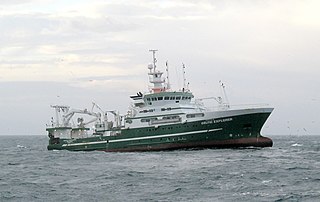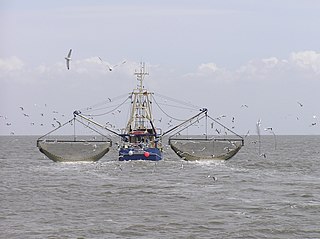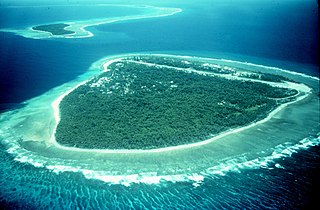Related Research Articles

Trawling is an industrial method of fishing that involves pulling a fishing net, that is heavily weighted to keep it on the seafloor, through the water behind one or more boats. The net used for trawling is called a trawl. This principle requires netting bags which are towed through water to catch different species of fishes or sometimes targeted species. Trawls are often called towed gear or dragged gear.

Bycatch, in the fishing industry, is a fish or other marine species that is caught unintentionally while fishing for specific species or sizes of wildlife. Bycatch is either the wrong species, the wrong sex, or is undersized or juveniles of the target species. The term "bycatch" is also sometimes used for untargeted catch in other forms of animal harvesting or collecting. Non-marine species that are caught but regarded as generally "undesirable" are referred to as rough fish or coarse fish.

An artificial reef (AR) is a human-created freshwater or marine benthic structure. Typically built in areas with a generally featureless bottom to promote marine life, it may be intended to control erosion, protect coastal areas, block ship passage, block the use of trawling nets, support reef restoration, improve aquaculture, or enhance scuba diving and surfing. Early artificial reefs were built by the Persians and the Romans.

Bottom trawling is trawling along the seafloor. It is also referred to as "dragging". The scientific community divides bottom trawling into benthic trawling and demersal trawling. Benthic trawling is towing a net at the very bottom of the ocean and demersal trawling is towing a net just above the benthic zone. Bottom trawling can be contrasted with midwater trawling, where a net is towed higher in the water column. Midwater trawling catches pelagic fish such as anchovies and mackerel, whereas bottom trawling targets both bottom-living fish (groundfish) and semi-pelagic species such as cod, squid, shrimp, and rockfish.

Marine conservation, also known as ocean conservation, is the protection and preservation of ecosystems in oceans and seas through planned management in order to prevent the over-exploitation of these marine resources. Marine conservation is informed by the study of marine plants and animal resources and ecosystem functions and is driven by response to the manifested negative effects seen in the environment such as species loss, habitat degradation and changes in ecosystem functions and focuses on limiting human-caused damage to marine ecosystems, restoring damaged marine ecosystems, and preserving vulnerable species and ecosystems of the marine life. Marine conservation is a relatively new discipline which has developed as a response to biological issues such as extinction and marine habitats change.

Unsustainable fishing methods refers to the utilization of the various fishing methods in order to capture or harvest fish at a rate which sees the declining of fish populations over time. These methods are observed to facilitate the destructive fishing practices that destroy ecosystems within the ocean, and more readily results in overfishing, the depletion of fish populations at a rate that cannot be sustained.

Callum Michael Roberts is a British marine conservation biologist, oceanographer, science communicator, author and research scholar at the University of Exeter. He was formerly at the University of York. He is best known for his research and advocacy related to marine reserves and the environmental impact of fishing.

The environmental impact of fishing includes issues such as the availability of fish, overfishing, fisheries, and fisheries management; as well as the impact of industrial fishing on other elements of the environment, such as bycatch. These issues are part of marine conservation, and are addressed in fisheries science programs. According to a 2019 FAO report, global production of fish, crustaceans, molluscs and other aquatic animals has continued to grow and reached 172.6 million tonnes in 2017, with an increase of 4.1 percent compared with 2016. There is a growing gap between the supply of fish and demand, due in part to world population growth.

The habitat of deep-water corals, also known as cold-water corals, extends to deeper, darker parts of the oceans than tropical corals, ranging from near the surface to the abyss, beyond 2,000 metres (6,600 ft) where water temperatures may be as cold as 4 °C (39 °F). Deep-water corals belong to the Phylum Cnidaria and are most often stony corals, but also include black and thorny corals and soft corals including the Gorgonians. Like tropical corals, they provide habitat to other species, but deep-water corals do not require zooxanthellae to survive.

Rigs-to-Reefs (RTR) is the practice of converting decommissioned offshore oil and petroleum rigs into artificial reefs. Such biotic reefs have been created from oil rigs in the United States, Brunei and Malaysia. In the United States, where the practice started and is most common, Rigs-to-Reefs is a nationwide program developed by the former Minerals Management Service (MMS), now Bureau of Safety and Environmental Enforcement (BSEE), of the U.S. Department of the Interior.

A wild fishery is a natural body of water with a sizeable free-ranging fish or other aquatic animal population that can be harvested for its commercial value. Wild fisheries can be marine (saltwater) or lacustrine/riverine (freshwater), and rely heavily on the carrying capacity of the local aquatic ecosystem.
Destructive fishing practices are fishing practices which easily result in irreversible damage to habitats and the sustainability of the fishery ecosystems. Such damages can be caused by direct physical destruction of the underwater landform and vegetation, overfishing indiscriminate killing/maiming of aquatic life, disruption of vital reproductive cycles, and lingering water pollution.
Janet Patricia Gibson is a biologist and zoologist from Belize. She was awarded the Goldman Environmental Prize in 1990 for her efforts on conservation of the marine ecosystems along the Belizean coast, in particular the barrier reef system. The Belize Barrier Reef was granted UNESCO World Heritage status in 1996, through efforts of Gibson and others. She is the current director of the Belize Wildlife Conservation Society.

Coral reef protection is the process of modifying human activities to avoid damage to healthy coral reefs and to help damaged reefs recover. The key strategies used in reef protection include defining measurable goals and introducing active management and community involvement to reduce stressors that damage reef health. One management technique is to create Marine Protected Areas (MPAs) that directly limit human activities such as fishing.

Human activities have substantial impact on coral reefs, contributing to their worldwide decline.[1] Damaging activities encompass coral mining, pollution, overfishing, blast fishing, as well as the excavation of canals and access points to islands and bays. Additional threats comprise disease, destructive fishing practices, and the warming of oceans.[2] Furthermore, the ocean's function as a carbon dioxide sink, alterations in the atmosphere, ultraviolet light, ocean acidification, viral infections, the repercussions of dust storms transporting agents to distant reefs, pollutants, and algal blooms represent some of the factors exerting influence on coral reefs. Importantly, the jeopardy faced by coral reefs extends far beyond coastal regions. The ramifications of climate change, notably global warming, induce an elevation in ocean temperatures that triggers coral bleaching—a potentially lethal phenomenon for coral ecosystems.
The resilience of coral reefs is the biological ability of coral reefs to recover from natural and anthropogenic disturbances such as storms and bleaching episodes. Resilience refers to the ability of biological or social systems to overcome pressures and stresses by maintaining key functions through resisting or adapting to change. Reef resistance measures how well coral reefs tolerate changes in ocean chemistry, sea level, and sea surface temperature. Reef resistance and resilience are important factors in coral reef recovery from the effects of ocean acidification. Natural reef resilience can be used as a recovery model for coral reefs and an opportunity for management in marine protected areas (MPAs).

Fisheries-induced evolution (FIE) is the microevolution of an exploited aquatic organism's population, brought on through the artificial selection for biological traits by fishing practices. Fishing, of any severity or effort, will impose an additional layer of mortality to the natural population equilibrium and will be selective to certain genetic traits within that organism's gene pool. This removal of selected traits fundamentally changes the population gene frequency, resulting in the artificially induced microevolution by the proxy of the survival of untargeted fish and their propagation of heritable biological characteristics. This artificial selection often counters natural life-history pattern for many species, such as causing early sexual maturation, diminished sizes for matured fish, and reduced fecundity in the form of smaller egg size, lower sperm counts and viability during reproductive events. These effects can have prolonged effects on the adaptability or fitness of the species to their environmental factors.

Marine Conservation Cambodia (MCC) is a non-profit, marine conservation organisation based in Koh Ach Seh, Kep archipelago.
Scalicus engyceros is a species of marine ray-finned fish belonging to the family Peristediidae, the armoured gurnards or armored sea robins. This species is found in northwestern Pacific Ocean.
Alan Friedlander is an American marine ecologist and fisheries scientist focusing on protecting ocean habitats and incorporating traditional indigenous knowledge into contemporary conservation management. Friedlander was the lead author of the first study to describe inverted biomass pyramids in un-fished coral reef ecosystems. He has authored or contributed to over 400 publications, book chapters, and articles that have been cited over 15,000 times. As chief scientist for National Geographic's Pristine Seas Project, Friedlander has led over 40 expeditions resulting in the creation of 26 new marine reserves protecting more than 6.5 million square kilometers of remote and exceptional ocean habitats.
References
- ↑ "Creation of the Artificial Shellfish Reefs and Anti Trawling Devices". Marine Conservation Cambodia - Volunteer Internship in Marine Conservation and Research. 2016-10-14. Archived from the original on 2021-01-17. Retrieved 2021-01-17.
- ↑ Tessier, A; Verdoit-Jarraya, M; Blouet, S; Dalias, N; Lenfant, P (2014-05-07). "A case study of artificial reefs as a potential tool for maintaining artisanal fisheries in the French Mediterranean Sea". Aquatic Biology . Inter-Research Science Center. 20 (3): 255–272. doi: 10.3354/ab00563 . ISSN 1864-7782.
- ↑ Iannibelli, M.; Musmarra, D. (2008). "Effects of anti-trawling artificial reefs on fish assemblages: The case of Salerno Bay (Mediterranean Sea)". Italian Journal of Zoology . Informa. 75 (4): 385–394. doi: 10.1080/11250000802365290 . ISSN 1125-0003. S2CID 84091089.
- ↑ Juan J. Muñoz-Pérez; Jose M. Gutiérrez Mas; Jose M. Naranjo; Enrique Torres; Lorenzo Fages (September 2000). "Position and monitoring of anti-trawling reefs in the Cape of Trafalgar (Gulf of Cadiz, SW Spain)". Bulletin of Marine Science. 67 (2): 761–77.
- ↑ Serrano, Alberto; Rodríguez-Cabello, Cristina; Sánchez, Francisco; Velasco, Francisco; Olaso, Ignacio; Punzón, Antonio (2010-06-02). "Effects of anti-trawling artificial reefs on ecological indicators of inner shelf fish and invertebrate communities in the Cantabrian Sea (southern Bay of Biscay)". Journal of the Marine Biological Association of the United Kingdom . Cambridge University Press (CUP). 91 (3): 623–633. doi:10.1017/s0025315410000329. ISSN 0025-3154. S2CID 86041772.
- ↑ Ramos-EsplÁ, Alfonso A.; GuillÉn, Juan E.; Bayle, Just T.; SÁnchez-JÉrez, Pablo (2000). "Artificial Anti-trawling Reefs off Alicante, South-Eastern Iberian Peninsula: Evolution of Reef Block and Set Designs". Artificial Reefs in European Seas. Dordrecht: Springer Netherlands. pp. 195–218. doi:10.1007/978-94-011-4215-1_12. ISBN 978-0-7923-6144-2.
- ↑ "Anti-trawling block "NETTUNO"". Acquatecno. 2016-07-26. Retrieved 2021-01-17.
- ↑ "Subtidal Benthic Invertebrate Conservation: Global Evidence for the Effects of Interventions".
- ↑ "Install physical barriers to prevent trawling". Conservation Evidence. Retrieved 2021-01-17.
- ↑ "Spain investigating claims that Gibraltar has further blocked bay". El País . 2013-08-23. Retrieved 2021-01-17.
- ↑ "Fishing Protection - OPEC Egypt". 2017-07-17. Retrieved 2021-01-17.
- ↑ "Gibraltar Dispute: Spanish Fishermen in Reef Protest - Other Media news". Tasnim News Agency . 2013-08-19. Retrieved 2021-01-17.
- ↑ Macura, Biljana; Byström, Pär; Airoldi, Laura; Eriksson, Britas Klemens; Rudstam, Lars; Støttrup, Josianne G. (2019-03-12). "Impact of structural habitat modifications in coastal temperate systems on fish recruitment: a systematic review". Environmental Evidence . Collaboration for Environmental Evidence (BMC). 8 (1): 14. Bibcode:2019EnvEv...8...14M. doi: 10.1186/s13750-019-0157-3 . hdl: 11577/3401331 . ISSN 2047-2382. S2CID 84831487.
Conclusions: This review revealed a very limited evidence base for how structural modifications and marine urban sprawl can affect fish recruitment. Thus, there is a substantial mismatch between stakeholder needs and research evidence. Further, the impact and ecological performance of artificial structures depend both on context and species. Clearly, there is a need for more research on the subject, especially on long-term consequences at larger spatial scales.
- 1 2 Baine, Mark (2001). "Artificial reefs: a review of their design, application, management and performance". Ocean & Coastal Management . Elsevier. 44 (3–4): 241–259. Bibcode:2001OCM....44..241B. doi:10.1016/s0964-5691(01)00048-5. ISSN 0964-5691.
Their use as a tool in coastal management has many general purposes including ... the prevention of trawling in Europe [4]. Artificial reef reviews do exist [5] although varying in their focus and objectivity. ... Number of papers ... Anti-trawling ... 5 ... These respective case studies refer to the use of vessels and concrete modules for the prevention of illegal trawling in the Mediterranean Sea ...
- 1 2 Airoldi, Laura; Beck, Michael W.; Firth, Louise B.; Bugnot, Ana B.; Steinberg, Peter D.; Dafforn, Katherine A. (2021-01-03). "Emerging Solutions to Return Nature to the Urban Ocean". Annual Review of Marine Science . Annual Reviews. 13 (1): 445–477. Bibcode:2021ARMS...13..445A. doi:10.1146/annurev-marine-032020-020015. hdl: 10026.1/16842 . ISSN 1941-1405. PMID 32867567. S2CID 221402720.
4.1.1.1. Artificial reefs. Artificial reefs are one of the earliest approaches to greening gray infrastructure ... providing multiple additional benefits. These benefits include blocking ... the use of trawling nets ... (Baine 2001). ... The effectiveness of artificial reefs is debated (Macura et al. 2019), and even when their stated primary objectives have been achieved, they come with negative impacts: They are expensive (Pioch & Doumenge 2010), and distortions or abuses of the concept have offered pretext for ocean dumping or for uncritical equation of any artificial structure to a reef (Macdonald 1994). However, the lessons learned have laid the foundations for new adaptive and biomimetic design concepts (Airoldi et al. 2005, Dafforn et al. 2015a, O'Shaughnessy et al. 2020), which aim to integrate some of the scopes of artificial reef design into structures built for other primary functions (Firth et al. 2014, Perkol-Finkel et al. 2012).
- 1 2 3 Pears, R.; Williams, D. (2005). Potential effects of artificial reefs on the Great Barrier Reef: background paper. Townsville, Qld, Australia: Australian Government Cooperative Research Centres Program CRC Reef Research Centre. pp. 1–33. ISBN 1-876054-54-9.